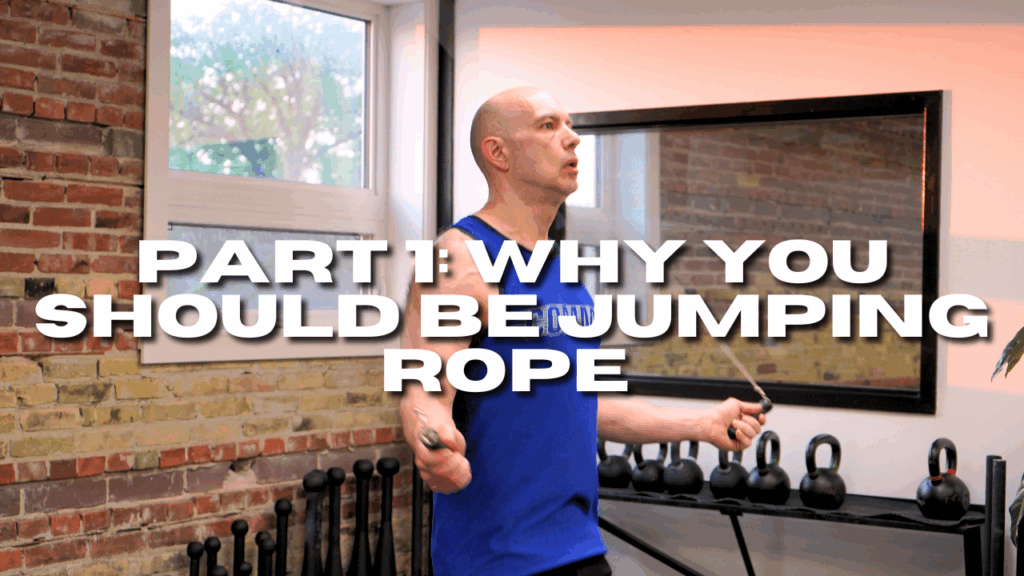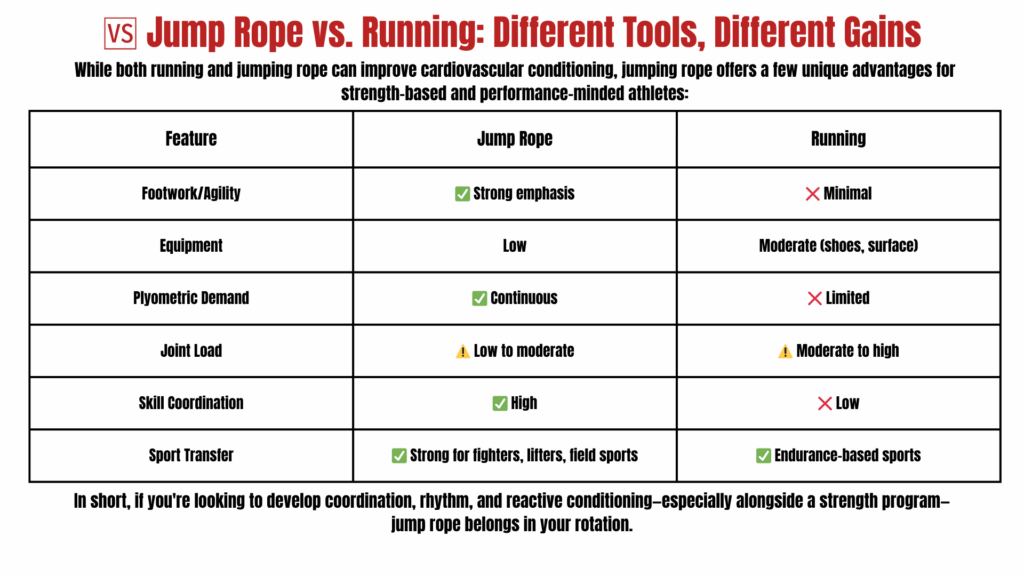
At first glance, jumping rope seems simple—just a rope and a rhythm. But if you’ve ever seen a fighter glide across the floor in perfect time, or a skilled athlete use a rope to warm up before a heavy lift, you know there’s something much deeper going on.
Jumping rope isn’t just a throwback to schoolyard games or a boxer’s warm-up routine. It’s one of the most efficient and effective tools for developing coordination, conditioning, and athletic control—and it belongs in more than just fight camps.
At White Lion Strong, we believe in training for power, precision, and performance—and jumping rope delivers all three.
🔥 Why Jump Rope Belongs in Your Program
🫀 1. Boosts Conditioning and Work Capacity
Jumping rope quickly elevates your heart rate and challenges your cardiovascular system. Studies show it can improve VO₂ max, endurance, and aerobic efficiency just as well—if not better—than traditional cardio like running or cycling
It’s scalable, too. A consistent rhythm and bounce builds aerobic capacity, while shorter bursts with complex footwork or double-unders push your anaerobic threshold. That means you’re training both energy systems—just like you would in sport or competition.
⚡ 2. Enhances Athletic Coordination and Footwork
Jump rope requires precise timing between your feet, wrists, shoulders, and core. The result? Improved neuromuscular coordination, rhythm, and control—key traits for athletes, lifters, and anyone who wants to move well under fatigue.
Athletes across disciplines—from martial arts to field sports—use skipping drills to sharpen footwork and reactivity. If your training includes sprinting, jumping, pivoting, or striking, rope work reinforces the speed and lightness you need under pressure.
🧠 3. Trains the Brain and Body Together
Jumping rope builds what coaches call movement literacy. Your body learns to respond to fast timing cues, sync breath with movement, and stay mentally engaged for longer durations. That has a powerful carryover to sports—and life.
The rhythm of skipping also creates a neurological pattern that helps people enter a flow state. Studies in sports psychology have shown that repetitive rhythmic movement increases focus and reduces anxiety by stimulating the brain’s sensory-motor circuits [2].
🦶 4. Strengthens the Ankles, Calves, and Posterior Chain
Each bounce is a low-impact plyometric—training the stretch-shortening cycle in your calves and ankles. Over time, this builds the kind of spring and stiffness you want in explosive movements like sprinting, jumping, and cutting.
And because you stay upright and aligned while skipping, you engage your glutes, hamstrings, and postural muscles the entire time. It’s not just cardio—it’s controlled, loaded movement through the entire posterior chain.
🧱 5. Builds Work Ethic Without Beating Up the Joints
Done properly, skipping is far less jarring than many high-impact cardio methods. Ground contact is brief, and the vertical displacement is low. You’re developing power and conditioning with far less wear on the knees and hips than running.
And since it requires very little space or gear, it’s a go-to for low-barrier, high-value training. You can use it to warm up, spike your heart rate between strength sets, or build aerobic base on recovery days—without hammering your joints or CNS.
🧰 Who Should Be Jumping Rope?
✅ Ideal for:
- Combat athletes, field athletes, and dancers
- Strength athletes looking to improve work capacity and warm-up efficiency
- Lifters who need better footwork, rhythm, or active recovery tools
- Coaches and trainers building athletic base in youth or general clients
- Anyone who wants to train movement instead of just muscle
⚠️ Caution for:
- Individuals recovering from ankle, knee, or low back injuries
- Deconditioned beginners or those with poor joint control (start slowly, with shorter sessions and soft surfaces)

🧪 Research Highlights
- VO₂ Max Gains: Skipping rope three times per week improved cardiovascular endurance in college men more than jogging for the same duration.
- Neural Efficiency: The rhythmic nature of jumping rope enhances sensorimotor synchronization, a key factor in reducing mental fatigue and improving athletic timing.
- Lower Limb Performance: Regular jump rope training improved lower-limb stiffness and jumping performance in youth athletes.
- Balance and Proprioception: Studies in older adults found that rope skipping significantly improved balance and dynamic coordination over a 12-week training period.
🏁 Ready to Try It?
If you’ve never used a jump rope seriously, start simple:
⏱️ 30 seconds on / 30 seconds off
Repeat for 4–6 rounds
Focus on relaxed shoulders, staying light on your feet, and finding your rhythm.
That’s all you need to begin building your conditioning base, tuning your coordination, and laying the groundwork for more advanced rope work down the road.
🦁 At White Lion Strong, We Train Like It Matters
Jump rope isn’t just “cardio.” It’s an expression of coordination, rhythm, and controlled explosiveness. Whether you’re loading a barbell, entering a fight camp, or just trying to stay sharp into your 40s and beyond—how you move matters.
And sometimes, the simplest tools give you the most honest feedback.
Stay tuned for Part 2, where we’ll cover how to choose the right rope, fix common mistakes, and unlock the foundations of great skipping technique.
📚 References:
- Baker, J.A. (2013). Comparison of Rope Skipping and Jogging as Methods of Improving Cardiovascular Efficiency of College Men. Research Quarterly.
- Thaut, M. H. (2005). Rhythm, Music, and the Brain. Taylor & Francis.
- Kubo et al. (2007). Effects of jump training on passive stiffness of the gastrocnemius. Eur J Appl Physiol.
Rogan et al. (2013). Effects of rope skipping training on balance and motor coordination in elderly adults. J Aging Phys Act.